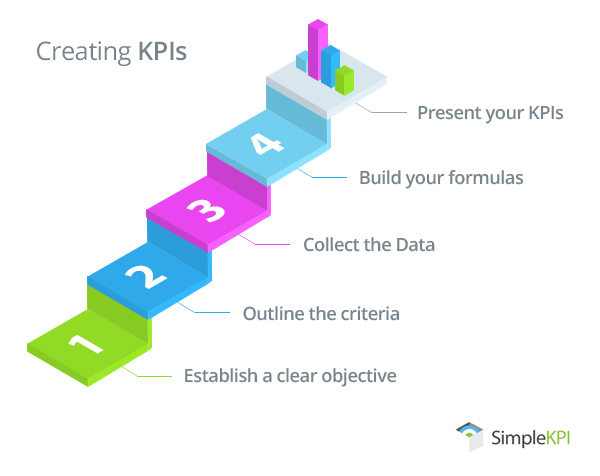What is a KPI?
A Key Performance Indicator (KPI) is a type of measure that is used to evaluate the performance of an organization against its strategic objectives. KPIs help to cut the complexity associated with performance tracking by reducing a large amount of measures into a practical number of ‘key’ indicators.
KPIs can be used to track the operational performance of departments, projects or individuals against targets or goals. They can provide a management tool for gaining insight and decision making.
What do KPIs look like?
Unlike simple Metrics that are used to monitor and present values, such as the number of visitors to a website. KPIs may incorporate one or many different metrics to track a business objective. For example, a KPI aligned to a strategic marketing objective may look like this:
- Objective: Increase the website conversion rate to 20%.
- Description: The current conversion rate has stalled at 12%. To be competitive the conversion rate needs to increase in line with our competitors.
- Completion: By the End of the year.
- Reporting Frequency: Monthly.
- Visual:
- Data Source: Number of Trials / Number of conversions.
- Owner: Product Manager.
A well-constructed KPI helps organizations translate visions into strategies, and tracks the impact of initiatives. Companies benefit from a host of advantages, such as greater insight and real time information to make informed decisions.
How to create KPIs in 5 simple steps
Developing meaningful KPIs that track, and clearly visualize performance takes some planning. Each KPI needs to address a specific business objective, and provide timely, accurate information to assess progress towards goals.
Essentially, creating successful KPIs comes down to understanding the aspirations of the business using a clear, structured process for crafting KPIs.

Here’s how to create a KPI:
Need Information or Confused about Something ?
Ask a Question- Establish a clear objective.
If a goal of the business is to be the ‘market leader’, then a KPI objective maybe to ‘increase revenue by 10% this financial year’ or ‘Expand our product lines to 20’. State clearly, and in simple terms the purpose of the KPI. This provides guidance for anyone viewing the KPI to interpret the data in the correct context. - Outline the criteria for success.
What will the target be? Is it attainable? when should it be accomplished? and how will progress be monitored? Targets should be realistic, changes to business processes take time to implement. In the initial stages of KPI monitoring it’s best to focus on long-term targets with midterm monitoring. - Collect the data.
Investigate the availability and accuracy of the data. Data may be available automatically from existing systems or hidden in reports and databases. This data will all need to be pulled together at regular intervals for reporting in one central place. - Build the KPI formula.
Some KPIs contain but a single metric or measure. However most rely on a combination brought together under a single calculated formula. For example, a KPI that measures productivity in revenue by machine would look like this: Total Revenue divided by the total number of machines. Build formulas and create calculations with test data to see if the results are what you would expect. - Present your KPIs.
To efficiently communicate your KPIs you’ll need to translate the data into understandable visuals such as graphs and charts. Dashboards for Operational KPIs, or Reports for Strategic KPIs offer a convenient way to create, track and distribute your KPIs.
Did You Know : Top 15 Free Online Learning Platforms
-
Free Online Education Degrees : Coursera:
Coursera partners with universities and organizations worldwide to offer a wide range of courses. While many courses are free, a fee is often required for certification.
-
Free Online Education Degrees: edX:
Founded by MIT and Harvard, edX offers high-quality courses from top universities and institutions around the world. Certificates are available for a fee.
-
Free Online Education Degrees : Khan Academy:
Khan Academy provides free educational content in various subjects, especially mathematics and science, using instructional videos and practice exercises.
-
Free Online Education Degrees : Udacity:
Udacity focuses on tech-related courses and nanodegree programs, offering free content as well as more in-depth paid programs.
-
Free Online Education Degrees : MIT OpenCourseWare (OCW):
MIT OCW provides a vast array of MIT's course content for free, covering a wide range of disciplines.
-
Free Online Education Degrees : Harvard Extension School:
Harvard Extension School offers a selection of free online courses. While some courses are free, others may require payment for a certificate.
-
Free Online Education Degrees: Stanford Online:
Stanford Online offers a variety of free courses in different disciplines, including computer science, engineering, and business.
-
Best Free Online Courses : Carnegie Mellon Open Learning Initiative (OLI):
OLI offers free online courses and resources designed to improve learning outcomes through research-based methodologies.
-
Best Free Online Courses : FutureLearn:
FutureLearn partners with universities and institutions to offer a diverse range of free online courses. Certificates are available for a fee.
-
Best Free Online Courses: Alison:
Alison offers a wide range of free online courses, including diploma and certificate programs, covering various subjects.
-
Best Free Online Courses: Open Yale Courses:
Yale University provides free access to a selection of introductory courses through Open Yale Courses.
-
Best Free Online Courses : UC Berkeley Online:
UC Berkeley offers free online courses on a variety of subjects, ranging from computer science to humanities.
-
Best Free Online Courses : Google Digital Garage:
Google Digital Garage provides free courses on digital skills, including online marketing, data analysis, and more.
-
Best Free Online Courses : Codecademy:
Codecademy offers free coding courses, interactive exercises, and coding projects to help individuals learn programming languages.
-
Best Free Online Courses : LinkedIn Learning (formerly Lynda.com):
LinkedIn Learning provides a variety of video courses on professional development, technology, and creative skills. It offers a free trial period.